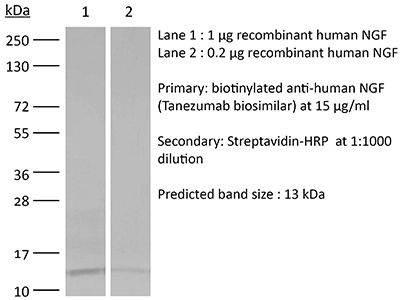InVivoSIM anti-human NGF (Tanezumab Biosimilar)
Product Description
Specifications
| Isotype | Human IgG2, κ |
|---|---|
| Recommended Isotype Control(s) | InVivoPlus human IgG2 isotype control |
| Recommended Dilution Buffer | InVivoPure pH 7.0 Dilution Buffer |
| Conjugation | This product is unconjugated. Conjugation is available via our Antibody Conjugation Services. |
| Immunogen | Human NGF |
| Reported Applications |
in vivo NGF neutralization ELISA |
| Formulation |
PBS, pH 7.0 Contains no stabilizers or preservatives |
| Endotoxin |
≤0.5EU/mg (≤0.0005EU/μg) Determined by LAL assay |
| Aggregation |
<5% Determined by SEC |
| Purity |
≥95% Determined by SDS-PAGE |
| Sterility | 0.2 µm filtration |
| Purification | Protein A |
| RRID | AB_2927533 |
| Molecular Weight | 150 kDa |
| Murine Pathogen Tests |
Ectromelia/Mousepox Virus: Negative Hantavirus: Negative K Virus: Negative Lactate Dehydrogenase-Elevating Virus: Negative Lymphocytic Choriomeningitis virus: Negative Mouse Adenovirus: Negative Mouse Cytomegalovirus: Negative Mouse Hepatitis Virus: Negative Mouse Minute Virus: Negative Mouse Norovirus: Negative Mouse Parvovirus: Negative Mouse Rotavirus: Negative Mycoplasma Pulmonis: Negative Pneumonia Virus of Mice: Negative Polyoma Virus: Negative Reovirus Screen: Negative Sendai Virus: Negative Theiler’s Murine Encephalomyelitis: Negative |
| Storage | The antibody solution should be stored at the stock concentration at 4°C. Do not freeze. |
| Need a Custom Formulation? | See All Antibody Customization Options |
Application References
in vivo NGF neutralization
Hayes BW, Choi HW, Rathore APS, Bao C, Shi J, Huh Y, Kim MW, Mencarelli A, Bist P, Ng LG, Shi C, Nho JH, Kim A, Yoon H, Lim D, Hannan JL, Purves JT, Hughes FM, Ji RR, Abraham SN (2024). "Recurrent infections drive persistent bladder dysfunction and p
PubMed
Urinary tract infections (UTIs) account for almost 25% of infections in women. Many are recurrent (rUTI), with patients frequently experiencing chronic pelvic pain and urinary frequency despite clearance of bacteriuria after antibiotics. To elucidate the basis for these bacteria-independent bladder symptoms, we examined the bladders of patients with rUTI. We noticed a notable increase in neuropeptide content in the lamina propria and indications of enhanced nociceptive activity. In mice subjected to rUTI, we observed sensory nerve sprouting that was associated with nerve growth factor (NGF) produced by recruited monocytes and tissue-resident mast cells. Treatment of rUTI mice with an NGF-neutralizing antibody prevented sprouting and alleviated pelvic sensitivity, whereas instillation of native NGF into naïve mice bladders mimicked nerve sprouting and pain behavior. Nerve activation, pain, and urinary frequency were each linked to the presence of proximal mast cells, because mast cell deficiency or treatment with antagonists against receptors of several direct or indirect mast cell products was each effective therapeutically. Thus, our findings suggest that NGF-driven sensory sprouting in the bladder coupled with chronic mast cell activation represents an underlying mechanism driving bacteria-independent pain and voiding defects experienced by patients with rUTI.
Product Citations
-
-
Neuroscience
Recurrent infections drive persistent bladder dysfunction and pain via sensory nerve sprouting and mast cell activity.
In Sci Immunol on 1 March 2024 by Hayes, B. W., Choi, H. W., et al.
PubMed
Urinary tract infections (UTIs) account for almost 25% of infections in women. Many are recurrent (rUTI), with patients frequently experiencing chronic pelvic pain and urinary frequency despite clearance of bacteriuria after antibiotics. To elucidate the basis for these bacteria-independent bladder symptoms, we examined the bladders of patients with rUTI. We noticed a notable increase in neuropeptide content in the lamina propria and indications of enhanced nociceptive activity. In mice subjected to rUTI, we observed sensory nerve sprouting that was associated with nerve growth factor (NGF) produced by recruited monocytes and tissue-resident mast cells. Treatment of rUTI mice with an NGF-neutralizing antibody prevented sprouting and alleviated pelvic sensitivity, whereas instillation of native NGF into naïve mice bladders mimicked nerve sprouting and pain behavior. Nerve activation, pain, and urinary frequency were each linked to the presence of proximal mast cells, because mast cell deficiency or treatment with antagonists against receptors of several direct or indirect mast cell products was each effective therapeutically. Thus, our findings suggest that NGF-driven sensory sprouting in the bladder coupled with chronic mast cell activation represents an underlying mechanism driving bacteria-independent pain and voiding defects experienced by patients with rUTI.
-
-
-
Neuroscience
Recurrent infections drive persistent bladder dysfunction and pain via sensory nerve sprouting and mast cell activity.
In Science Immunology on 1 March 2024 by Hayes, B. W., Choi, H. W., et al.
Urinary tract infections (UTIs) account for almost 25% of infections in women. Many are recurrent (rUTI), with patients frequently experiencing chronic pelvic pain and urinary frequency despite clearance of bacteriuria after antibiotics. To elucidate the basis for these bacteria-independent bladder symptoms, we examined the bladders of patients with rUTI. We noticed a notable increase in neuropeptide content in the lamina propria and indications of enhanced nociceptive activity. In mice subjected to rUTI, we observed sensory nerve sprouting that was associated with nerve growth factor (NGF) produced by recruited monocytes and tissue-resident mast cells. Treatment of rUTI mice with an NGF-neutralizing antibody prevented sprouting and alleviated pelvic sensitivity, whereas instillation of native NGF into naïve mice bladders mimicked nerve sprouting and pain behavior. Nerve activation, pain, and urinary frequency were each linked to the presence of proximal mast cells, because mast cell deficiency or treatment with antagonists against receptors of several direct or indirect mast cell products was each effective therapeutically. Thus, our findings suggest that NGF-driven sensory sprouting in the bladder coupled with chronic mast cell activation represents an underlying mechanism driving bacteria-independent pain and voiding defects experienced by patients with rUTI.
-

